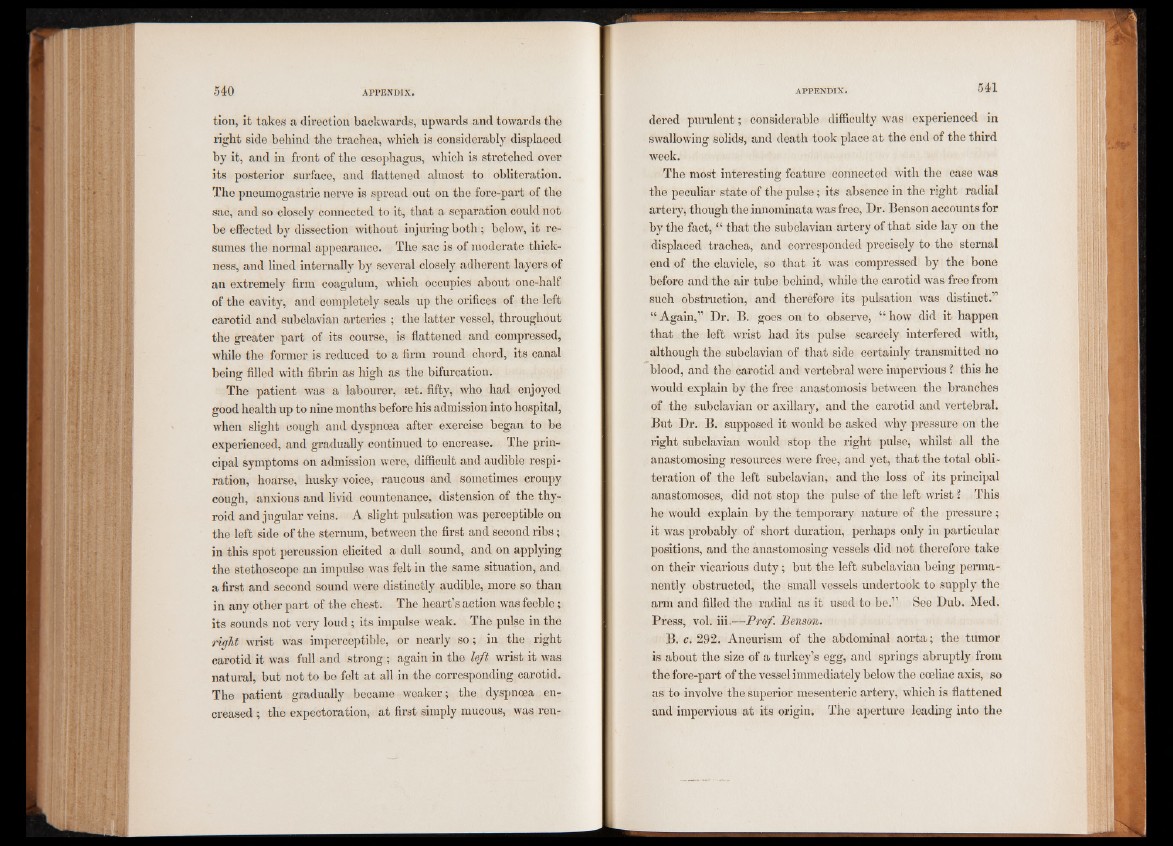
tion, it takes a direction backwards, upwards and towards the
right side behind the trachea, which is considerably displaced
by it, and in front of the oesophagus, which is stretched over
its posterior surface, and flattened almost to obliteration.
The pneumogastric nerve is spread out on the fore-part of the
sac, and so closely connected to it, that a separation could not
be effected by dissection without injuring both; below, it resumes
the normal appearance. The sac is of moderate thickness,
and lined internally by several closely adherent layers of
an extremely firm coagulum, which occupies about one-half
of the cavity, and completely seals up the orifices of the left
carotid and subclavian arteries ; the latter vessel, throughout
the greater part of its course, is flattened and compressed,
while the former is reduced to a firm round chord, its canal
being filled with fibrin as high as the bifurcation.
The patient was a labourer, aet. fifty, who had enjoyed
good health up to nine months before his admission into hospital,
when slight cough and dyspnoea after exercise began to be
experienced, and gradually continued to encrease. The principal
symptoms on admission were, difficult and audible respiration,
hoarse, husky voice, raucous and sometimes croupy
cough, anxious and livid countenance, distension of the thyroid
and jugular veins. A slight pulsation was perceptible on
the left side of the sternum, between the first and second ribs;
in this spot percussion elicited a dull sound, and on applying
the stethoscope an impulse was felt in the same situation, and
a first and second sound were distinctly audible, more so than
in any other part of the chest. The heart’s action was feeble;
its sounds not very loud; its impulse weak. The pulse in the
right wrist was imperceptible, or nearly so; in the right
carotid it was full and strong ; again in the left wrist it was
natural, but not to be felt at all in the corresponding carotid.
The patient gradually became weaker; the dyspnoea en-
creased ; the expectoration, at first simply mucous, was rendered
purulent; considerable difficulty was experienced in
swallowing solids, and death took place at the end of the third
week.
The most interesting feature connected with the case was
the peculiar state of the pulse; its absence in the right radial
artery, though the innominata was free, Dr. Benson accounts for
by the fact, & that the subclavian artery of that side lay on the
displaced trachea, and corresponded precisely to the sternal
end of the clavicle, so that it was compressed by the bone
before and the air tube behind, while the carotid was free from
such obstruction, and therefore its pulsation was distinct.”
1 Again,” Dr. B. goes on to observe, “ how did it happen
that the left wrist had its pulse scarcely interfered with,
although the subclavian of that side certainly transmitted no
blood, and the carotid and vertebral were impervious ? this he
would explain by the free anastomosis between the branches
of the subclavian or axillary, and the carotid and vertebral.
But Dr. B. supposed it would be asked why pressure on the
right subclavian would stop the right pulse, whilst all the
anastomosing resources were free, and yet, that the total obliteration
of the left subclavian, and the loss of its principal
anastomoses, did not stop the pulse of the left wrist 2 This
he would explain by the temporary nature of the pressure;
it was probably of short duration, perhaps only in particular
positions, and the anastomosing vessels did not therefore take
on their vicarious duty; but the left subclavian being permanently
obstructed, the small vessels undertook to supply the
arm and filled the radial as it used to be.” See Dub. Med.
Press, vol. iii.—Prof. Benson.
B. c. 292. Aneurism of the abdominal aorta; the tumor
is about the size of a turkey’s egg, and springs abruptly from
the fore-part of the vessel immediately below the coeliac axis, so
as to involve the superior mesenteric artery, which is flattened
and impervious at its origin. The aperture leading into the